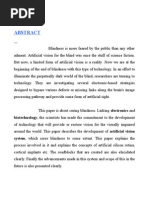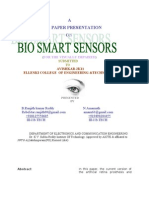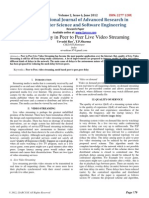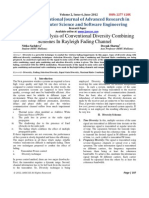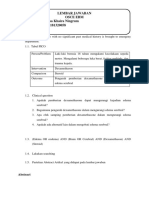V2I1048
V2I1048
Uploaded by
editor_ijarcsseCopyright:
Available Formats
V2I1048
V2I1048
Uploaded by
editor_ijarcsseCopyright
Available Formats
Share this document
Did you find this document useful?
Is this content inappropriate?
Copyright:
Available Formats
V2I1048
V2I1048
Uploaded by
editor_ijarcsseCopyright:
Available Formats
Volume 2, Issue 1, January 2012
ISSN: 2277 128X
International Journal of Advanced Research in Computer Science and Software Engineering
Research Paper Available online at: www.ijarcsse.com
An Artificial Vision Approach For Blind Human in Emerging Scenario of Neural Network Using Neurons Activity
Mr. Dinesh Chandra Jain
Research Schoolar in Comp-Science SRTM University Nanded (M.S)
Dr. V. P. Pawar
Associate Professor , School of Comp- Science SRTM University Nanded (M.S)
Abstract- This paper represents the significance of Neurons in the Neural network. How it is shows its importance when any tissue or layers of retina damaged. Blindness is more feared by the public than any other ailment. Artificial vision for the blind was once the stuff of artificial neural network in the field of computer science. But now, a limited form of artificial vision is a reality .Now we are at the beginning of the end of blindness with this type of technology. In an effort to illuminate the perpetually dark world of the blind, the technology has to be emerged that is electronic-based strategies designed to bypass various defects or missing links along the brain's image processing pathway and provide some form of artificial sight. There are two methods for curing blindness that will provide or restore vision which is Artificial Silicon Retina and artificial retina component chip for the visually impaired around the world. Keywords - Neural Network , Neurons ,Vision, ASR, ARCC.
I.
INTRODUCTION
The curing of blindness is the most challenging and important area. Artificial-vision researchers take inspiration from another device, the cochlear implant, which has successfully restored hearing to thousands of deaf people. But the human vision system is far more complicated than that of hearing. The eye is one of the most amazing organs in the body. Before we understand how artificial vision is created, it's important to know about the important role that the retina plays in how we see. Following points indicates the explanation of what happens when we look at an object: Scattered light from the object enters through the cornea. The light is projected onto the retina. The retina sends messages to the brain through the optic nerve. The brain interprets what the object is.
Figures (1): Architecture of eye
Figures (2): The anatomy of the eye and its path view
Volume 2, issue 1, January 2012
www.ijarcsse.com
concept for both devices is similar, with each being: Small enough to be implanted in the eye Supplied with a continuous source of power Biocompatible with the surrounding eye tissue
Figures (3): Neurons activity of the eye
The retina is complex in itself. This thin membrane at the back of the eye is a vital part of our ability to see[1]. Its main function is to receive and transmit images to the brain. These are the three main types of cells in the eye that help perform this function: Rods, Cones and Ganglion Cells. The information received by the rods and cones are transmitted to the nearly 1 million ganglion cells in the retina. These ganglion cells interpret the messages from the rods and cones and send the information on to the brain by way of the optic nerve. There are a number of retinal diseases that attack these cells, which can lead to blindness. The most notable of these diseases are retinitis pigmentosa and agerelated macular degeneration. Both of these diseases attack the retina, rendering the rods and cones inoperative, causing either loss of peripheral vision or total blindness. However, it's been found that neither of these retinal diseases affects the ganglion cells or the optic nerve. This means that if scientists can develop artificial cones and rods, information could still be sent to the brain for interpretation. This concept laid the foundation for the invention of the artificial vision system technology. II. HOW TO CREATE ARTIFICIAL VISION A blind person could be made to see light by stimulating the nerve ganglia behind the retina with an electrical current. This test proved that the nerves behind the retina still functioned even when the retina had degenerated. Based on this information, scientists set out to create a device that could translate images and electrical pulses that could restore vision[2]. Today, such a device is very close to be available to the millions of people who have lost their vision to retinal disease. In fact, there are at least two silicon microchip devices that are being developed. The 2012, IJARCSSE All Rights Reserved
Figures (4,5) The dot above the date on this penny is the full size of the Artificial Silicon Retina.
Perhaps the most promising of these two silicon devices is the artificial silicon retina. The ASR is an extremely tiny device. It has a diameter of just 2 mm (.078 inch) and is thinner than a human hair. In order for an artificial retina to work it has to be small enough so that doctors can transplant it in the eye without damaging the other structures within the eye. Groups of researchers have found that blind people can see spots of light when electrical currents stimulate cells, following the experimental insertion of an electrode device near or into their retina. Some patients even saw crude shapes in the form of these light spots. This indicates that despite damage to cells in the retina, electronic techniques can transmit signals to the next step in the pathway and provide some form of visual sensation. Researchers are currently developing more sophisticated computer chips with the hope
Volume 2, issue 1, January 2012
www.ijarcsse.com
that they will be able to transmit more meaningful images to the brain. III. HOW DOES ARTIFICIAL SILICON RETINA WORKS The ASR contains about 3,500 microscopic solar cells that are able to convert light into electrical pulses, mimicking the function of cones and rods. To implant this device into the eye, surgeons make three tiny incisions no larger than the diameter of a needle in the white part of the eye. Through these incisions, the surgeons introduce a miniature cutting and vacuuming device that removes the gel in the middle of the eye and replaces it with saline[3]. Next, a pinpoint opening is made in the retina through which they inject fluid to lift up a portion of the retina from the back of the eye, which creates a small pocket in the sub retinal space for the device to fit in. The retina is then resealed over the ASR.
the artificial retina component chip, this device is quite similar to the ASR. Both are made of silicon and both are powered by solar energy. The ARCC is also a very small device measuring 2 mm square and a thickness of .02 millimeters (.00078 inch). There are significant differences between the devices, however. According to researchers, the ARCC will give blind patients the ability to see 10 by 10 pixel images, which is about the size of a single letter on this page. However, researchers have said that they could eventually develop a version of the chip that would allow 250 by 250 pixel array, which would allow those who were once blind to read a newspaper. IV. WORKING OF ARTIFICIAL VISION SYSTEM The main parts of this system are miniature video camera, a signal processor, and the brain implants. The tiny pinhole camera, mounted on a pair of eyeglasses, captures the scene in front of the wearer and sends it to a small computer on the patient's belt. The processor translates the image into a series of signals that the brain can understand, and then sends the information to the brain implant that is placed in patients visual cortex. And, if everything goes according to plan, the brain will "see" the image.
Figure (6) :Here you can see where the ASR is placed between the outer and inner retinal layers.
For any microchip to work it needs power, and the amazing thing about the ASR is that it receives all of its needed power from the light entering the eye. This means that with the ASR implant in place behind the retina, it receives all of the light entering the eye[4]. This solar energy eliminates the need for any wires, batteries or other secondary devices to supply power. Another microchip device that would restore partial vision is currently in development called 2012, IJARCSSE All Rights Reserved
Figures (7,8) Artificial Vision System.
Volume 2, issue 1, January 2012
www.ijarcsse.com
Light enters the camera, which then sends the image to a wireless wallet-sized computer for processing. The computer transmits this information to an infrared LED screen on the goggles[5]. The goggles reflect an infrared image into the eye and on to the retinal chip, stimulating photodiodes on the chip. The photodiodes mimic the retinal cells by converting light into electrical signals, which are then transmitted by cells in the inner retina via nerve pulses to the brain[6]. The goggles are transparent so if the user still has some vision, they can match that with the new information the device would cover about 10 of the wearers field of vision. The patient should wear sunglasses with a tiny pinhole camera mounted on one lens and an The electrodes stimulate certain brain cells, making the person perceive the specks of light. The shifting patterns as scans across a scene tells him where light areas meet dark ones, letting him find the black cap on the white wall, for example. The device provides a sort of tunnel vision, reading an area about the size of a card 2 inches wide and 8 inches tall, held at arm's length. The electronic eye is the latest in high-tech gadgets aimed at helping millions of blind and visually impaired people. Although the images produced by the artificial eye were far from perfect, they could be clear enough to allow someone who is otherwise blind to recognize faces. The first useful artificial eye is now helping a blind man walk safely around and read large letters. Several efforts are now underway to create vision in otherwise blind eyes. While technically exciting, much more work in this area needs to be completed before anything is available to the majority of patients. Research is ongoing in two areas: cortical implants and retinal implants. There is still an enormous amount of work to be done in developing artificial retinas. In recent years, progress is being made towards sensory distribution devices for the blind. In the long run, there could be the possibility of brain implants. A brain implant or cortical implant provides visual input from a camera directly to the brain via electrodes in contact with the visual cortex at the backside of the head.
ultrasonic range finder on the other. Both devices communicate with a small computer carried on his hip, which highlights the edges between light and dark areas in the camera image. It then tells an adjacent computer to send appropriate signals to an array of small electrodes on the surface of patients brain, through wires entering his skull.
V. CONCLUSION The applied methods and technique will be helpful for the blind person to gain the vision artificially from the innovative ideas. VI. REFERENCES
1.Humayun MS, de Juan E Jr., Dagnelie G, et al. Visual perception elicited by electrical stimulation of retina in
blind humans. Archives of Ophthalmology; vol 114. 2. Artificial Vision for the Blind by Connecting a Television Camera to the Brain" ASAIO Journal 2000 3.www.artificialvision.com 4.www.howstuffworks.com 5.www.wikipedia.org 6. www.itotd.com
AUTHOR PROFILE
Mr. Dinesh Chandra Jain
has completed B.E (Comp-Sc) in 2004 and M.Tech (IT) degree in 2007. He is pursuing PhD
in computer science from SRTM university Nanded (M.S), in the field of Human Computer Interaction and Brain Computer Interaction.
Pawar received MS,Ph.D.(Computer) Degree from Dept .CS & IT, Dr.B.A.M. University & PDF from ES, University of Cambridge, UK. Also Received MCA (SMU), MBA (VMU) degrees respectively. He has receivedprestigious fellowship from DST, UGRF (UGC), Sakaal foundation, ES London, ABC (USA) etc. He has published 90 and more research papers in reputed national international Journals & conferences. He has recognize Ph.D Guide from University of une, SRTM University & Sighaniya University (India). He is senior IEEE member and other reputed society member.
Dr.Vrushsen
2012, IJARCSSE All Rights Reserved
Volume 2, issue 1, January 2012
www.ijarcsse.com
Currently working as a Professor & Director in SICA institute is affiliated to University of pune..
2012, IJARCSSE All Rights Reserved
You might also like
- PCCN PrepDocument133 pagesPCCN Prepdaniel100% (2)
- Robotic Surgery Technical ManualDocument10 pagesRobotic Surgery Technical Manualapi-346387336No ratings yet
- Artificial Vision: Towards Creating The Joys of Seeing For The BlindDocument11 pagesArtificial Vision: Towards Creating The Joys of Seeing For The BlindSrijan YallaNo ratings yet
- Blind Was Once The Stuff of Science Fiction. But Now, A Limited Form of Artificial Vision Is ADocument14 pagesBlind Was Once The Stuff of Science Fiction. But Now, A Limited Form of Artificial Vision Is ASateesh KumarNo ratings yet
- Ar VI FoDocument9 pagesAr VI Fobasu33No ratings yet
- Artificial Vision: M.Sonika P.Srikanth Iv/Iv B.Tech (E.C.E)Document11 pagesArtificial Vision: M.Sonika P.Srikanth Iv/Iv B.Tech (E.C.E)itabassum5No ratings yet
- Artificial VisionDocument9 pagesArtificial VisionvijayakumarnknNo ratings yet
- Eye DocumentationDocument18 pagesEye DocumentationJavaharReddyNo ratings yet
- Artificial Vision: (Towards Creating The Joys of Seeing For The Blind MadeDocument16 pagesArtificial Vision: (Towards Creating The Joys of Seeing For The Blind Mademourya0091No ratings yet
- Creating The Joy of Sight For The BlindDocument9 pagesCreating The Joy of Sight For The BlindmycatalystsNo ratings yet
- Artificial Vision: Jntu AnantapurDocument7 pagesArtificial Vision: Jntu AnantapurAshwinkumar KavaliNo ratings yet
- Electronic Eye: ("For Blind and Beyond")Document25 pagesElectronic Eye: ("For Blind and Beyond")Cuty DeepsNo ratings yet
- Artificial Vision - A Bionic EyeDocument8 pagesArtificial Vision - A Bionic EyesunkimanasaNo ratings yet
- Krishna VeniDocument7 pagesKrishna VeniPrinlova PandaNo ratings yet
- Artificial VisionDocument7 pagesArtificial Visionmahi07404No ratings yet
- See The World The Argus: Retina Electrical Electrodes Implant CameraDocument5 pagesSee The World The Argus: Retina Electrical Electrodes Implant CameraUpendra_Reddy_8780No ratings yet
- Artificial VisionDocument16 pagesArtificial VisionPriya PanyamNo ratings yet
- Artificial Vision - A Bionic EyeDocument12 pagesArtificial Vision - A Bionic EyesahanasatishNo ratings yet
- Soumya Bionic EyeDocument17 pagesSoumya Bionic EyePriti ChoudharyNo ratings yet
- Artificial Vision: Paper Submitted byDocument8 pagesArtificial Vision: Paper Submitted byNani KasulaNo ratings yet
- Bionic EyeDocument20 pagesBionic EyeMegha BhatiaNo ratings yet
- Artificial Vision LakkireddyDocument9 pagesArtificial Vision LakkireddyDeejay SahirNo ratings yet
- Jayam College of Engineering and Technology: Electronic-Eye: For The BlindDocument8 pagesJayam College of Engineering and Technology: Electronic-Eye: For The Blindgirishprabhaker69No ratings yet
- Bionic EyeDocument6 pagesBionic EyeChandu GudeNo ratings yet
- Artificial Retina: Presented byDocument6 pagesArtificial Retina: Presented bySai KrishnaNo ratings yet
- Bionic EyeDocument9 pagesBionic EyeNarava VivekNo ratings yet
- Bionic Eyes: Towards Creating The Joy of Sight For The BlindDocument9 pagesBionic Eyes: Towards Creating The Joy of Sight For The BlindVed Shekhar GowdaNo ratings yet
- Bionic Eye: A Paper Presentation OnDocument19 pagesBionic Eye: A Paper Presentation OnYellaReddy TarigopulaNo ratings yet
- Artificial RetinaDocument6 pagesArtificial RetinavenkateshmukharjiNo ratings yet
- Bionic Eye - An Artificial Vision & Comparative Study Based On Different Implant TechniquesDocument9 pagesBionic Eye - An Artificial Vision & Comparative Study Based On Different Implant TechniquesGabi BermudezNo ratings yet
- An Overview - Artificial Eye (Bionic Eye) : K. Pradeep, K. Vasantha Kokilam and C. SunithaDocument4 pagesAn Overview - Artificial Eye (Bionic Eye) : K. Pradeep, K. Vasantha Kokilam and C. SunithaTimberevilake HardjosantosoNo ratings yet
- Eye 4Document4 pagesEye 4Omar SalaheldinNo ratings yet
- Artificial EyesDocument16 pagesArtificial EyesViki Kumar0% (1)
- Bharathiyar College of Engineering and TechnologyDocument26 pagesBharathiyar College of Engineering and TechnologyHãrîNo ratings yet
- Artificial VisionDocument8 pagesArtificial VisionARVINDNo ratings yet
- 3592-Ophthalmologists and Physicists Team Up To Design Bionic EyeDocument4 pages3592-Ophthalmologists and Physicists Team Up To Design Bionic EyeSumeet SethyNo ratings yet
- Artificial VisionDocument8 pagesArtificial VisionHarish KandragulaNo ratings yet
- Bionic Eye: Made by IqbalDocument24 pagesBionic Eye: Made by IqbalIqbal Hussain100% (1)
- R. Angeline Prabha & J.Lavina Mary: Jacsi College of Engg. NazarethDocument17 pagesR. Angeline Prabha & J.Lavina Mary: Jacsi College of Engg. NazarethRose EdwardNo ratings yet
- Bio Smart SensorsDocument10 pagesBio Smart SensorsAmar NathNo ratings yet
- Ijeeer - Bionic Eye - An Artificial VisionDocument8 pagesIjeeer - Bionic Eye - An Artificial VisionTJPRC Publications100% (1)
- Literature Review On Bionic EyeDocument6 pagesLiterature Review On Bionic Eyeafmzkbuvlmmhqq100% (1)
- Nature 2013 12439Document2 pagesNature 2013 12439Buse Nur AkçayNo ratings yet
- Neural InkDocument17 pagesNeural InkDevajith mohan100% (4)
- Artificial Vision TechnicalDocument30 pagesArtificial Vision TechnicalDebangi GoswamiNo ratings yet
- .Bionic Eye A New InventionDocument4 pages.Bionic Eye A New InventionSharadhiNo ratings yet
- Bionic Eye PaperDocument9 pagesBionic Eye PaperJaseela NasarNo ratings yet
- Presented By: V.Priyanka, 16C81A0520, Iv Btech (Cse)Document18 pagesPresented By: V.Priyanka, 16C81A0520, Iv Btech (Cse)Priyanka vadapalliNo ratings yet
- Bionic Eye Seminar ReportDocument26 pagesBionic Eye Seminar Reportsaadhu_s0% (1)
- Bionic Arm Brainport Brain Tongue Vision Light: Digital CameraDocument2 pagesBionic Arm Brainport Brain Tongue Vision Light: Digital CameraGopikrishna NallamothuNo ratings yet
- Artificial Vision Using Embedded System: Y.Selvendri. C.SruthiDocument7 pagesArtificial Vision Using Embedded System: Y.Selvendri. C.SruthiRahul RawatNo ratings yet
- Bionic Eye ReportDocument18 pagesBionic Eye Reportgagandeep_saluja_2No ratings yet
- Bionic EyeDocument17 pagesBionic EyehardikNo ratings yet
- Artificialsiliconretinamain 110919140301 Phpapp02Document21 pagesArtificialsiliconretinamain 110919140301 Phpapp02Shelly NandalNo ratings yet
- Artificial EyeDocument33 pagesArtificial Eyemounica saiNo ratings yet
- A Ray of Vision For The BlindDocument34 pagesA Ray of Vision For The BlindTobaNo ratings yet
- Visual Perception: Insights into Computational Visual ProcessingFrom EverandVisual Perception: Insights into Computational Visual ProcessingNo ratings yet
- Target Classification: An Application of Artificial Neural Network in Intelligent Transport SystemDocument4 pagesTarget Classification: An Application of Artificial Neural Network in Intelligent Transport Systemeditor_ijarcsseNo ratings yet
- Impact and Utilization of Wireless Sensor Network in Rural Area For Health CareDocument6 pagesImpact and Utilization of Wireless Sensor Network in Rural Area For Health Careeditor_ijarcsseNo ratings yet
- Optimizing Delay in Peer To Peer Live Video StreamingDocument4 pagesOptimizing Delay in Peer To Peer Live Video Streamingeditor_ijarcsseNo ratings yet
- A Review of Various Grid Middleware TechnologiesDocument6 pagesA Review of Various Grid Middleware Technologieseditor_ijarcsseNo ratings yet
- Simulink Model Based Image SegmentationDocument4 pagesSimulink Model Based Image Segmentationeditor_ijarcsseNo ratings yet
- An Algorithm For Crypto Analysis in ManetDocument4 pagesAn Algorithm For Crypto Analysis in Maneteditor_ijarcsseNo ratings yet
- Key Distillation Process On Quantum Cryptography Protocols in Network SecurityDocument6 pagesKey Distillation Process On Quantum Cryptography Protocols in Network Securityeditor_ijarcsseNo ratings yet
- Performance Analysis of Conventional Diversity Combining Schemes in Rayleigh Fading ChannelDocument4 pagesPerformance Analysis of Conventional Diversity Combining Schemes in Rayleigh Fading Channeleditor_ijarcsseNo ratings yet
- Fingerprint Recognition Using Robust Local FeaturesDocument5 pagesFingerprint Recognition Using Robust Local Featureseditor_ijarcsseNo ratings yet
- V2I600131Document6 pagesV2I600131editor_ijarcsseNo ratings yet
- A Model For Real Time Sign Language Recognition SystemDocument7 pagesA Model For Real Time Sign Language Recognition Systemeditor_ijarcsseNo ratings yet
- V2I300142Document3 pagesV2I300142editor_ijarcsseNo ratings yet
- Performance Analysis of WDM/SCM System Using EDFADocument5 pagesPerformance Analysis of WDM/SCM System Using EDFAeditor_ijarcsseNo ratings yet
- SCTP Protocol Reviews and Performance in Ad-Hoc Multi-Homed NetworksDocument7 pagesSCTP Protocol Reviews and Performance in Ad-Hoc Multi-Homed Networkseditor_ijarcsseNo ratings yet
- An Evaluation of Weak State Mechanism For Large-Scale Dynamic NetworksDocument5 pagesAn Evaluation of Weak State Mechanism For Large-Scale Dynamic Networkseditor_ijarcsseNo ratings yet
- A Survey On Personalized Meta Search EngineDocument4 pagesA Survey On Personalized Meta Search Engineeditor_ijarcsseNo ratings yet
- Multi-Objective Approach For Software Module ClusteringDocument6 pagesMulti-Objective Approach For Software Module Clusteringeditor_ijarcsseNo ratings yet
- Knowledge Sharing Using Ontology-A Date Palm ModelDocument6 pagesKnowledge Sharing Using Ontology-A Date Palm Modeleditor_ijarcsseNo ratings yet
- Stages of Labor and DeliveryDocument4 pagesStages of Labor and DeliveryvienreyNo ratings yet
- Nurses' Knowledge and Practice Regarding Oral Care in Intubated Patients at Selected Teaching Hospitals, ChitwanDocument8 pagesNurses' Knowledge and Practice Regarding Oral Care in Intubated Patients at Selected Teaching Hospitals, ChitwanAnonymous izrFWiQNo ratings yet
- DyslipidemiaDocument20 pagesDyslipidemiaapi-261438047No ratings yet
- Cranial Nerve ExaminationDocument3 pagesCranial Nerve ExaminationtomodachiNo ratings yet
- Article-PDF-sheen Juneja Aman Arora Shushant Garg Surbhi-530Document3 pagesArticle-PDF-sheen Juneja Aman Arora Shushant Garg Surbhi-530JASPREETKAUR0410No ratings yet
- Case Study 2 Sandy LeDocument15 pagesCase Study 2 Sandy Leapi-381646671No ratings yet
- Katherine Jackson V AEG Live Transcripts of August 15th 2013 DR David SlavitDocument66 pagesKatherine Jackson V AEG Live Transcripts of August 15th 2013 DR David SlavitTeamMichaelNo ratings yet
- Dda Guideline NepalDocument3 pagesDda Guideline NepalImdadHussainOPositiveNo ratings yet
- Engl 316 Resume FinalDocument1 pageEngl 316 Resume Finalapi-466382256No ratings yet
- HA BSE Breast Self ExaminationDocument23 pagesHA BSE Breast Self ExaminationKBD100% (1)
- Pacslac Checklist With SM Logo PDFDocument2 pagesPacslac Checklist With SM Logo PDFMihaela Cosmina NiculescuNo ratings yet
- Chapter Vi Multidisciplinary and Sectoral Collaboration Lesson 1Document13 pagesChapter Vi Multidisciplinary and Sectoral Collaboration Lesson 1Sophia Kaye Aguinaldo100% (1)
- Distal Gastrectomy With B1, B2 Anastomsis orDocument57 pagesDistal Gastrectomy With B1, B2 Anastomsis orsjulurisNo ratings yet
- Transfer Discharge NoticeDocument2 pagesTransfer Discharge NoticeVeronica AfronieNo ratings yet
- Malaysian Snakebite Management GuidelineDocument113 pagesMalaysian Snakebite Management GuidelineMohd Syamirulah Rahim100% (3)
- Learning Plan End of Nurs 261Document4 pagesLearning Plan End of Nurs 261api-283946728No ratings yet
- Withdrawn BehaviorDocument5 pagesWithdrawn BehaviorFlorina Nadorra RamosNo ratings yet
- Difference Between CPT 99441 and 99421Document13 pagesDifference Between CPT 99441 and 99421Akash ChavanNo ratings yet
- Ottawa2012 Abstract Pp95Document209 pagesOttawa2012 Abstract Pp95Mohamed Abd El-Fattah GalalNo ratings yet
- CVS Case SheetDocument11 pagesCVS Case SheetSANA100% (1)
- Clinical Medical Assisting A Professional Field Smart Approach To The Workplace 2nd Edition by Heller ISBN Test BankDocument8 pagesClinical Medical Assisting A Professional Field Smart Approach To The Workplace 2nd Edition by Heller ISBN Test Bankyvette100% (31)
- Insulin Treatment in DiabetesDocument86 pagesInsulin Treatment in DiabetesAhsan Rauf100% (1)
- Case 01Document3 pagesCase 01o969059No ratings yet
- Non CariousDocument4 pagesNon CariousUpasana BhandariNo ratings yet
- How To Mix InsulinDocument2 pagesHow To Mix InsulinchareneadamsNo ratings yet
- PTSD and Autoimmune DiseasesDocument24 pagesPTSD and Autoimmune DiseasesEnida XhaferiNo ratings yet
- Kruger 02Document24 pagesKruger 02ab2653ncNo ratings yet
- Perbedaan NNT Pada Trial Effectiveness Dan NNT Trial Adverse EffectDocument8 pagesPerbedaan NNT Pada Trial Effectiveness Dan NNT Trial Adverse EffectUlquiorra SchifferNo ratings yet







